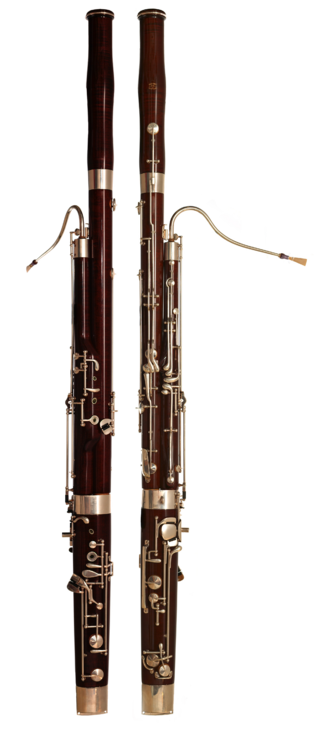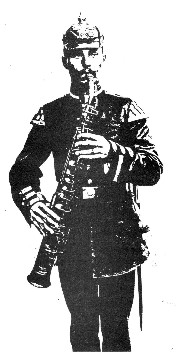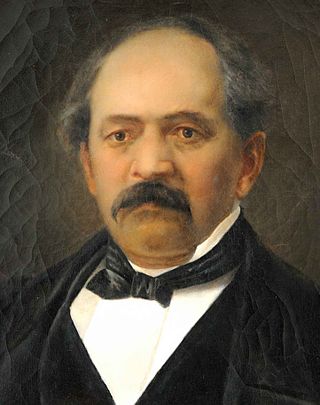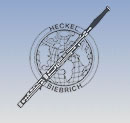
The bassoon is a musical instrument in the woodwind family, which plays in the tenor and bass ranges. It is composed of six pieces, and is usually made of wood. It is known for its distinctive tone color, wide range, versatility, and virtuosity. It is a non-transposing instrument and typically its music is written in the bass and tenor clefs, and sometimes in the treble. There are two forms of modern bassoon: the Buffet and Heckel systems. It is typically played while sitting using a seat strap, but can be played while standing if the player has a harness to hold the instrument. Sound is produced by rolling both lips over the reed and blowing direct air pressure to cause the reed to vibrate. Its fingering system can be quite complex when compared to those of other instruments. Appearing in its modern form in the 19th century, the bassoon figures prominently in orchestral, concert band, and chamber music literature, and is occasionally heard in pop, rock, and jazz settings as well. One who plays a bassoon is called a bassoonist.

The oboe is a type of double-reed woodwind instrument. Oboes are usually made of wood, but may also be made of synthetic materials, such as plastic, resin, or hybrid composites.
The contrabassoon, also known as the double bassoon, is a larger version of the bassoon, sounding an octave lower. Its technique is similar to its smaller cousin, with a few notable differences.
The heckelphone is a musical instrument invented by Wilhelm Heckel and his sons. The idea to create the instrument was initiated by Richard Wagner, who suggested its concept at the occasion of a visit of Wilhelm Heckel in 1879. Introduced in 1904, it is similar to the oboe but, like the bass oboe, pitched an octave lower, the heckelphone has a significantly larger bore.
The piccolo heckelphone is a very rare woodwind instrument invented in 1905 by the firm of Wilhelm Heckel in Wiesbaden-Biebrich, Germany. A variant of the heckelphone, the piccolo heckelphone was intended to add power to the very highest woodwind register of the late Romantic orchestra, providing a full and rich oboe-like sound well into the sopranino range. A transposing instrument pitched in F, a perfect fourth above the oboe, its written range is from B3 to E6, though it can reach tones as much as a third above this.

Biebrich is a borough of the city of Wiesbaden, Hesse, Germany. With over 38,000 inhabitants, it is the most-populated of Wiesbaden's boroughs. It is located south of the city center on the Rhine River, opposite the Mainz borough of Mombach. Biebrich was an independent city until it was incorporated into Wiesbaden in 1926.

The bass oboe or baritone oboe is a double reed instrument in the woodwind family. It is essentially twice the size of a regular (soprano) oboe so it sounds an octave lower; it has a deep, full tone somewhat akin to that of its higher-pitched cousin, the English horn. The bass oboe is notated in the treble clef, sounding one octave lower than written. Its lowest sounding note is B2 (in scientific pitch notation), one octave and a semitone below middle C, although an extension with an additional key may be inserted between the lower joint and bell of the instrument in order to produce a low B♭2. The instrument's bocal or crook first curves away from and then toward the player (unlike the bocal/crook of the English horn and oboe d'amore), looking rather like a flattened metal question mark; another crook design resembles the shape of a bass clarinet neckpiece. The bass oboe uses its own double reed, similar to but larger than that of the English horn.
The surname Heckel can refer to:

The piccolo oboe, also known as the piccoloboe or sopranino oboe and historically called an oboe musette, is the smallest and highest pitched member of the oboe family. Pitched in E♭ or F above the regular oboe, the piccolo oboe is a sopranino version of the oboe, comparable to the E♭ clarinet. It is most commonly found in early 20th-century marching band music, and more rarely in chamber music ensembles or contemporary compositions.

A Holztrompete, generally refers to natural trumpets whose conical or cylindrical blowpipe is made of wood and can be from half a meter to five meters long. The best-known wooden trumpet is the Swiss alphorn. Their design and traditional function was as a signaling and warning instrument used by shepherds and sometimes for ritual occasions.

A single-reed instrument is a woodwind instrument that uses only one reed to produce sound. The very earliest single-reed instruments were documented in ancient Egypt, as well as the Middle East, Greece, and the Roman Empire. The earliest types of single-reed instruments used idioglottal reeds, where the vibrating reed is a tongue cut and shaped on the tube of cane. Much later, single-reed instruments started using heteroglottal reeds, where a reed is cut and separated from the tube of cane and attached to a mouthpiece of some sort. By contrast, in a double reed instrument, there is no mouthpiece; the two parts of the reed vibrate against one another. Reeds are traditionally made of cane and produce sound when air is blown across or through them. The type of instruments that use a single reed are clarinets and saxophone. The timbre of a single and double reed instrument is related to the harmonic series caused by the shape of the corpus. E.g. the clarinet is only including the odd harmonics due to air column modes canceling out the even harmonics. This may be compared to the timbre of a square wave.
The clarinet d'amore or clarinet d'amour is a musical instrument, a member of the clarinet family.

The heckelphone-clarinet (or Heckelphon-Klarinette) is a rare woodwind instrument, invented in 1907 by Wilhelm Heckel in Wiesbaden-Biebrich, Germany. Despite its name, it is essentially a wooden saxophone with wide conical bore, built of red-stained maple wood, overblowing the octave, and with clarinet-like fingerings. It has a single-reed mouthpiece attached to a short metal neck, similar to an alto clarinet. The heckelphone-clarinet is a transposing instrument in B♭ with sounding range of D3 (middle line of bass staff) to C6 (two ledger lines above the treble staff), written a whole tone higher. The instrument is not to be confused with the heckel-clarina, also a very rare conical bore single reed woodwind by Heckel but higher in pitch and made of metal, nor with the heckelphone, a double reed instrument lower in pitch.

The heckel-clarina, also known as clarina or patent clarina, is a very rare woodwind instrument, invented and manufactured by Wilhelm Heckel in Wiesbaden-Biebrich, Germany. Heckel received a patent for the instrument on 8 December 1889. It was apparently intended to be used for the shepherd’s pipe solo in Act III of Wagner's Tristan und Isolde. It was used beginning in 1891 at the Festspielhaus, Bayreuth as a substitute for Wagner's Holztrompete; the clarina was found more practical and more effective in producing the desired tone-colour.

The Lupophon is an extremely rare woodwind instrument in the oboe family that plays in a lower pitch than standard, and was developed by Guntram Wolf of Kronach and Benedikt Eppelsheim of Munich, Germany, manufactured by Guntram Wolf. The instrument takes its name after the Italian translation of the inventor's surname, as the sarrusophone, the saxhorn, the saxophone, the heckelphone, and the rothphone are named after their inventors. It is in effect a modified heckelphone, with a slightly smaller bore and range down to low F. The lower portion of the instrument is folded back on itself in order to manage the considerable length of the tube, somewhat in the manner of a saxophone. The addition of the four lowest semitones allows it to cover the full intended range of the heckelphone part of Richard Strauss' Eine Alpensinfonie, which descends beyond that instrument's lowest note.

Johann Adam Heckel was a German instrument maker. He founded the family firm in Wiesbaden-Biebrich in 1831, and became the foremost German bassoon maker, making many improvements to the instrument. His company, Wilhelm Heckel GmbH, is still regarded as one of the top makers of bassoons in the world today. The company also makes contrabassoons and heckelphones.
Reed aerophones is one of the categories of musical instruments found in the Hornbostel-Sachs system of musical instrument classification. In order to produce sound with these Aerophones the player's breath is directed against a lamella or pair of lamellae which periodically interrupt the airflow and cause the air to be set in motion.
Vier Epigraphe nach Escher, Op. 35, is a chamber music composition by Graham Waterhouse, written in 1995 for viola, heckelphone and piano. Its four movements refer to graphic artworks by M. C. Escher. It was commissioned by Dr. Gunter Joppig and premiered in Munich in 1995. The piece was published by Hofmeister in 1998 and first performed in the U.S. in the same year.
Perplexities after Escher is a chamber music composition by Graham Waterhouse for heckelphone, string quartet and double bass. Its five movements refer to graphic artworks by M. C. Escher. It was composed between 2022 and 2024 for the 120th anniversary of the instrument heckelphone, and premiered in Garmisch-Partenkirchen. The piece is in preparation to be published by Schott.











